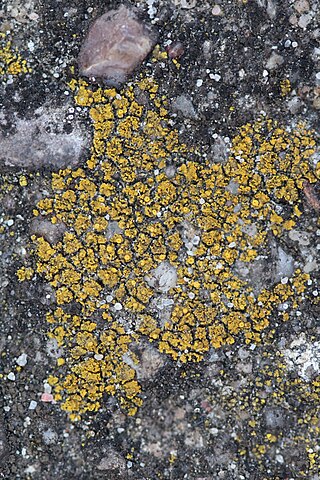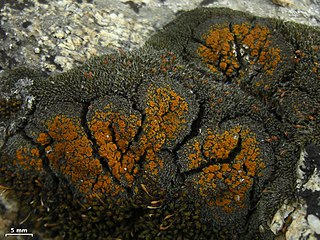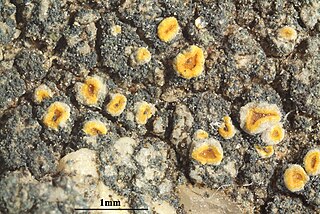
Flavoplaca is a genus of crust-like or scaly lichens in the family Teloschistaceae. It has 28 species with a mostly Northern Hemisphere distribution.
Variospora cancarixiticola is a species of saxicolous (rock-dwelling), crustose lichen in the family Teloschistaceae. It is found in southeastern Spain, where it grows on cancarixite, a volcanic rock known only to occur in that country.
Solitaria is a fungal genus in the family Teloschistaceae. It contains a single species, the corticolous (bark-dwelling), crustose lichen Solitaria chrysophthalma.

Wetmoreana brouardii is a species of saxicolous (rock-dwelling), crustose lichen in the family Teloschistaceae.
Calogaya alaskensis is a species of crustose lichen in the family Teloschistaceae. It was first described as new to science in 2004 by Clifford Wetmore, who placed it in the genus Caloplaca. Ulf Arup and colleagues transferred the taxon to Calogaya in 2013 following a molecular phylogenetics-led restructuring of the Teloschistaceae.
Usnochroma is a genus of lichen-forming fungi in the family Teloschistaceae. It has two species of crustose lichens. The genus was circumscribed in 2013 by lichenologists Ulrik Søchting, Ulf Arup, and Patrik Frödén, with Usnochroma carphineum assigned as the type species. The genus name refers to the yellowish-green colour of the thallus, which is caused by the substance usnic acid. Usnochroma species occur in Macaronesia, South Africa, the Mediterranean Basin, and Algeria.

Squamulea squamosa is a species of saxicolous (rock-dwelling), squamulose lichen in the family Teloschistaceae. Found in southwestern North America, it was first formally described by Maurice Bouly de Lesdain in 1933, as Placodium squamosum. Alexander Zahlbruckner proposed a transfer to genus Caloplaca in 1940, and the lichen was known as a member of that genus for more than seven decades. Ulf Arup and colleagues transferred the taxon to the genus Squamulea in 2013, following a molecular phylogenetics-based restructuring of the family Teloschistaceae.

Flavoplaca arcis is a species of saxicolous (rock-dwelling), crustose to squamulose (scaley) lichen in the family Teloschistaceae. Although widely distributed in Northern, Central, and Western Europe, it is not commonly encountered.
Sirenophila maccarthyi is a species of corticolous/lignicolous, crustose lichen in the family Teloschistaceae. It has a thallus that is whitish or greyish, often inconspicuous and not always continuous, which can appear darker or dirty grey near its numerous, clustered apothecia. Sirenophila maccarthyi is distributed across regions including Western Australia, New South Wales, Victoria, Tasmania, and New Zealand, in both coastal and inland habitats. It typically grows on the bark and dead wood of a wide range of trees and shrubs such as Acacia sophorae, Araucaria excelsa, and various Eucalyptus species.
Xanthocarpia erichansenii is a species of terricolous (ground-dwelling), crustose lichen in the family Teloschistaceae. It is found in southwest Greenland, where it grows on loess among mosses.
Caloplaca sol is a species of saxicolous (rock-dwelling), crustose lichen in the family Teloschistaceae. It is found on limestone and basic siliceous rocks along the southern and western shores of Great Britain.

Flavoplaca austrocitrina is a species of saxicolous (rock-dwelling), crustose lichen in the family Teloschistaceae. It is widely distributed in Europe, and has also been recorded in South America.

Parvoplaca tiroliensis is a species of crustose lichen in the family Teloschistaceae, and the type species of the genus Parvoplaca. It is widely distributed, and has been recorded growing on a variety of substrates, including moss, dead plant material, and bone.

Polycauliona bolacina, the waxy firedot lichen, is a species of saxicolous (rock-dwelling), crustose lichen in the family Teloschistaceae. It is found in western North America.
Flavoplaca kantvilasii is a species of saxicolous (rock-dwelling), crustose lichen in the family Teloschistaceae. Found in Australia, it was formally described as a new species in 2007.
Flavoplaca arcisproxima is a species of saxicolous (rock-dwelling), crustose lichen in the family Teloschistaceae. It is found primarily in the coastal regions of the Crimean Peninsula and the eastern Mediterranean, particularly in Crete, Greece.

Variospora thallincola is a species of saxicolous (rock-dwelling), crustose lichen in the family Teloschistaceae.

Flavoplaca oasis is a species of saxicolous (rock-dwelling), crustose lichen in the family Teloschistaceae. It is widely distributed across Europe, and has been reported in Western Asia, China, and North Africa.

Kuettlingeria soralifera is a saxicolous (rock-dwelling), crustose lichen species in the family Teloschistaceae, first described in 2006. It is similar to Kuettlingeria xerica but distinguished by the presence of soredia on its thallus.
Elixjohnia jackelixii is a species of saxicolous (rock-dwelling), crustose lichen in the family Teloschistaceae. It is found in Australia and New Zealand. The lichen is characterised by its unique multilayered appearance with outer sterile rings that are brownish or greenish-yellow and inner areoles that are whitish, yellowish, or greyish, often cracked to reveal the medulla underneath. Its fruiting bodies, or apothecia, are typically attached directly to the thallus and vary in colour and shape.










